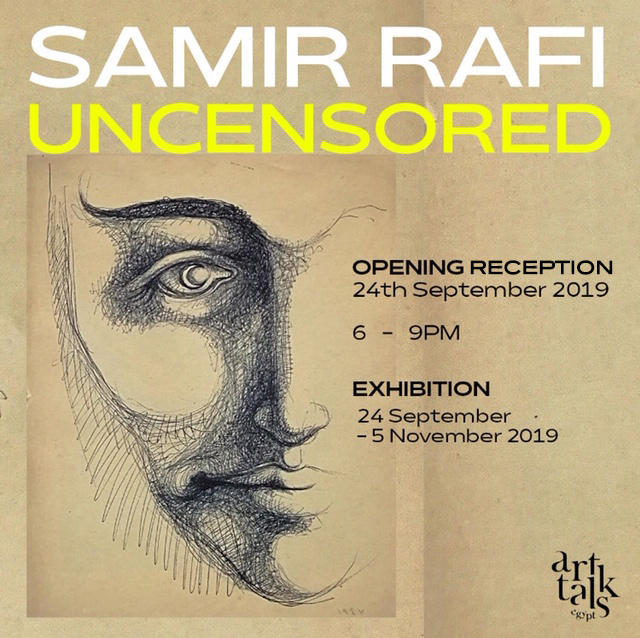
SAMIR RAFI UNCENSORED
سمير رافع : بِدونِ حَذْفٍ
Samir Rafi Uncensored sheds light on a puzzling artist, who seems to have never admitted that the grass is after all not greener on the other side.
Born in the Sakkakini district in Cairo on 15 August 1926, Samir Rafi was a painter, sculptor, arts educator and author. A prolific artist who used different media, (lost) objects, sculptures, drawings, collage, sketchbooks and tapestries, his tragic tale of hope is the subject of this exhibition. With more than fifty works spanning the early 1940s until his death in 2004, it invites a deeper examination into what Rafi dubbed in 1945 ‘an International Egyptian Surrealism movement’ or better yet, the “Rafi’sm” school of art, thereby recognizing Samir Rafi as the pioneer he truly was.
An ambitious individualist from the beginning, Samir Rafi was destined to an impressive career in his homeland. A prodigious trendsetter, he began his career in Egypt in the midst of World War II producing works that were far ahead of his time as a powerful mode of social criticism. His early interpretation of Egyptian ordinary life struggled and triumphed to express the huge oppressions, upheavals, and hard-won freedoms that have epitomized Egypt’s sprawl. In search of the unknown and the depth of human feelings, Rafi broke boundaries with visual innovations that linked Egyptian imagery with the human subconscious, and set out to draw a metaphysical blend of overlapping movements and styles to depict the Egyptian man, to which Rafi added ‘a universal soul.’ It was Rafi’s all-encompassing attempt at Egyptianizing surrealism, in search of a social and collective remedy. By 1945, Rafi had sealed the movement of “Rafi’sm” as a recognizable visual style. In 1946, he co-founded Jama’at al-Fann al-Mo’assir, an artist collective that became to be seen as the most inventive in twentieth century Egypt. This explains why the “Cairo Years” between 1942 and 1954 are generally considered the highpoint of his career, and cemented Rafi as one of Egypt’s most important revelations and artists.
Driven by the hope to achieve international recognition, Rafi however left Egypt at the peak of his career in June 1954. He remained abroad until his death, never returning, albeit for one month during the summer of 1964. Initially sent on a government scholarship to pursue doctorate studies in art history at the Sorbonne University in Paris, the then twenty-eight-year-old ambitious artist gambled when he decided to follow his dream of fame and to remain in Paris, leaving all behind and somehow getting lost along the way. But home in France did not seem fulfilling. In the summer of 1964, Rafi abandoned his career as a rising artist for a second time, ignored his thesis defense, and travelled to Algeria with a group of Algerian political freedom fighters. Rafi became a target and was imprisoned on suspicion of spying for the regime of Gamal Abdel Nasser. The sequence of events between Paris (1954-1964) and Alger (1964-1969), and back (1969-2004) turned into a long and painful tale. As someone who belonged neither in Egypt nor in France, his ability (or rather inability) to overcome obstacles became the subject of his work, which explains the more somber, enigmatic, highly sexual and darker side. As he reconciled different if not opposite aesthetic elements, Rafi eventually created a singular painting school that came to be defined as ‘Totalisme’ [Wholeness] or ‘Insaniya Shamla [Complete Humanism]. The ‘whole’ appears like “still” narratives with a mordant, or rather poignant wit, usually depicted in geometric and exaggeratedly executed brushstrokes. Animals played a significant role in the imaginary world of Samir Rafi. They are either entwined in the bodies of his subjects, or are their (sole) companion. What significance and meanings they carry offers a large space for interpretation. Along the way, Rafi’s themes became markedly more Egyptian, and a close alignment between his on- and off-canvas persona emerged, demonstrating a reclusive man torn between success and struggles, wealth and poverty, health and sickness, family and separation, fame and anonymity, freedom and prison, and eventually, loneliness and death.
Neither celebrated in his homeland, nor recognized as he had expected in Europe during his lifetime, Rafi’s legacy began to be revived when all his belongings in his two-bed room apartment in Paris were repatriated to Cairo following his death in 2004. Only then did Rafi begin to “taste” the appreciation he truly deserves in Egypt and the region, as well as in the so-coveted Western world.